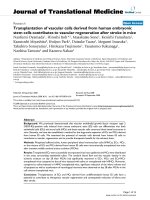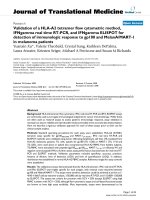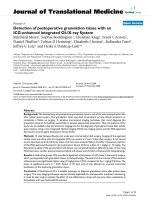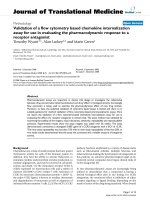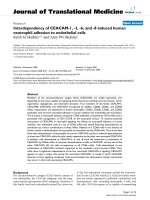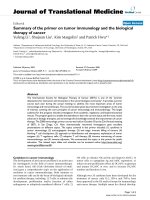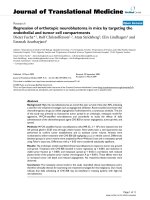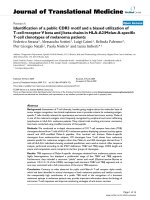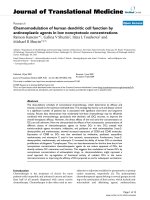Báo cáo hóa học: " Luminescence of colloidal CdSe/ZnS nanoparticles: high sensitivity to solvent phase transitions" ppt
Bạn đang xem bản rút gọn của tài liệu. Xem và tải ngay bản đầy đủ của tài liệu tại đây (1012.53 KB, 7 trang )
NANO EXPRESS Open Access
Luminescence of colloidal CdSe/ZnS
nanoparticles: high sensitivity to solvent
phase transitions
Andrei Antipov
1
,MattBell
1
, Mesut Yasar
1
, Vladimir Mitin
1*
, William Scharmach
2
, Mark Swihart
2
, Aleksandr Verevkin
1
,
Andrei S ergeev
1
Abstract
We investigate nanosecond photoluminescence processes in colloidal core/shell CdSe/ZnS nanoparticles dissolved
in water and found strong sensitivity of luminescence to the solvent state. Several pronounced changes have been
observed in the narrow temperature interval near the water melting point. First of all, the luminescence intensity
substantially (approximately 50%) increases near the transition. In a large temperature scale, the energy peak of the
photoluminescence decreases with temperature due to temperature dependence of the energy gap. Near the
melting point, the peak shows N-type dependence with the maximal changes of approximately 30 meV. The line
width increases with temperature and also shows N-type dependence near the melting point. The observed effects
are associated with the reconstruction of ligands near the ice/water phase transition.
Optical methods for the characterization of phase transi-
tions have attracted attention of many research groups
as sensitive, rapid, and extremely effective technique
which responds to small changes in crystallographic
structures, stress and local lattice distortio ns, changes in
stoichiometry, and dislocations [1-3]. Variety of lumines-
cence techniques such as thermoluminescence, electro-
luminescence, cathodoluminescence, X-ray irradiation,
and ion beam luminescence can be used for excitation
of luminescence [4]. A phase transition in bulk inevita-
bly alters luminescence spectra, line widths, efficiency of
excitation and recombination, excited state lifetimes,
and polarizatio n of emission bands. On the other hand,
the unique photoluminescence (PL) properties of colloi-
dal semiconductor nanoparticles (NPs) [5-7] with mini-
mal surface functionalization have potential not only as
imaging agents but also as local nan osensors due to
their high sensitivity to local environment. For example,
CdSe NPs placed in polymer matrix demonstrate signifi-
cant changes in their temperature-dependent PL inten-
sity and maximum PL spectral shifts. This phen omenon
can potentially be used for optical probing of local tem-
perature at nanoscale distances [8]. There are also
numerous reports [9,10], which show significant influ-
ences of the surface chemistry on optical properties of
colloidal NPs due to their large surface-to-volume ratios.
However, the real processes can be much more compli-
cated because NPs are partially c overed by capping
molecules depending on its shape, size, and surface
quality of NPs [10].
In this study, we demonstrate high sensitivity of P L of
colloidal NPs to the solve nt state. In a series of mea-
surements, we investigate the PL properties of CdSe/
ZnS core/shell colloidal nanoparticles dissolved in water
in the temperature range of 230-300 K. We also study
the dry CdSe Core nanoparticles for comparison.
The control dry colloidal NPs sample is prepared by a
spin coating of a dilute solution of 5.6-nm-diameter
CdSe NPs on clean glass cover slips. In-liquid samples
are prepared b y loading a highly diluted solution of the
same core-shell CdSe/Zn S NPs in water into a vacuum-
sealed low-temperature optical cell. In this optical cell,
the solution is held between two epitaxially polished
sapphire windows separated by a 0.5-mm-thick indium
foil spacer. Each sample is then mounted inside a
helium continuous-flow cryostat for low-temperature
* Correspondence:
1
Electrical Engineering Department, University at Buffalo, Buffalo,
NY 14260, USA
Full list of author information is available at the end of the article
Antipov et al. Nanoscale Research Letters 2011, 6:142
/>© 2011 Antipov et al; licensee Springer. This is an Open Access artic le distributed under the terms of the Creative Commons
Attribu tion License ( ), which permits unre stricted use, distributio n, and reproduction in
any medium, provided the original work is properly cited.
optical measurements over the temperature range of T =
10-300 K with temperature controlled to better than
0.5 K. The input window in cryostat was diffuse quartz,
which is completely transparent for the visible spectrum.
To avoid any possible oxidation of samples, they are iso-
lated in the pumped cryostat immed iately after prepar a-
tion and m easured. The NPs are excited by a l =532
nm Nd-vanadate laser with pulse r epetition rate of 76
MHz and 7 ps pulse duration. The photoluminescence
from NPs is collected by a h ome-built confocal micro-
scope and delivered to a 0.75-m-long imaging mono-
chromator coupled with a single-photon sensitiv e
electron-multiplication CCD camera. The photolumines-
cence from a sa mple is filtered by long-pas s 550-nm fil-
ter, which absorbs scattering light from a pump beam.
The PL intensit y of dry CdSe colloidal NPs as a
function of temperature and wavelength is sho wn in
Figur e 1a. The integrated emission i ntensity (integration
is done within l = 550-650 nm range) slightly decreases
as the temperature increases from 10 K up to 70 K.
Then, at higher temperatures, it quenches dramatically
in the temperature range of T = 70-300 K and exhibits
exponential behavior. We did not observe any significant
changes i n PL over that temperature range, except very
slow oscillation in PL tail. It is important to notice that
the saturation of PL intensity observe d in our experi-
ment at the temperatures below 50 K is certainly related
to the pulse repetition rate of the laser (12.5 ns) because
the low-temperature radiative lifetime of the exciton can
achieve an unusually long recombination time of 1 μsat
very low temperatures below 10 K and the stronger
dependence of PL intensity can be expected in experi-
ments with low repetition rate excitation [7].
Photoluminescence of the in-liquid sample dramatically
differs fr om dry NPs behavior and exhibits several local
peaks at some distinct temperatures in the temperature
range of 230-300 K. The most pronounced local maxi-
mum in PL intensity (approximately 50%) occurs near
the water freezing point T = 273 K (Figure 1b). However,
the temperature position of this maximum is shifted by
about 5 K below the expected phase transition tempera-
ture (see Figure 2).
PL peak energy of in-liqui d and dry coll oidal CdSe/
ZnS NPs in the temperature range of T = 240-290 K are
shown on Figure 3. In-liquid CdSe/ZnS NPs a re near
the water freezing point. The dashed and solid lines are
the best-fit curves to Varshni relation for dry and in-
liquid NPs, respectiv ely. It is clearly seen that PL peak
energy of in-liquid NPs exhibits not only the monotonic
temperature dependence similar to dry NPs sample but
the N-type feature near the solvent phase transition.
The PL peak energy increases by approximately 30 meV,
from approximately 2.07 eV to approximat ely 2.1 eV, as
the temperature changes from 260 to 270 K. Also, PL
peak energy at low and high temperatures decreases at
practically the same rate with increasing temperature.
PL full width at half maximum (FWHM) for in-liquid
CdSe/ZnS NPs in the temperature range of T = 240-290
K is shown on Figure 4. Another feature is observed
near the water freezing point. T he FWHM increases by
approximately 40 meV, from approximately 0.12 eV to
approximately 0.16 eV, as the temperature changes from
260 to 270 K. However, PL shows substantially different
behavior at low and high temperatures. The FWHM
decreases much faster in the temperature range T =
270-290 K than that at T = 240-260 K. Also, it is impor-
tant to notice that the FWHM for dry NPs does not
show peculiarities within the temperature range T =
240-290 K.
We also investigate the temperature dependence of
exciton lifetime of in-liquid CdSe/ZnS NPs near the
water freezing point. Time-resolved measurements are
performed using the time-correlated single-photon
counting system, PicoHarp 300. PL decay curves are
analyzed by multiexponential fitting. As it is shown in
theinsertofFigure5,PLresponseconsistsoftwo(fast
and slow) exponential components. The fa st component
of PL decay at T = 240-290 K is shown in Figure 5. It
undergoes the shift by appr oximately 200 ps, from 150
to 350 ps, within a temperature range of 260-270 K.
The fast component decreases in the temperature rang e
T = 240-260 K and slowly increases at T = 260-290 K.
The slow component of PL decay curve does not exhibit
anychangesinthetemperaturerangeT = 240-290 K
and stays the same for approximately 10 ns. The experi-
mental investigations of dry NPs show that there are no
changes in exciton lifetime as for the slow component
and for the fast component of PL decay curve within
the temperature range T = 240-290 K. New N-type fea-
ture that we report here correlates very well with the
behavior of exciton lifetime of in-liquid NPs near the
water freezing point.
We now discuss the above observed features in PL
behavior of in-liquid colloidal NPs. First, we exclude
possible external pressure effects during freezing. Kim
et al. [11] observed increase of photoluminescence peak
energy with pressure for dilute dispersions of CdSe
nanocrystals in toluene or 4-ethyl pyridine and attribu-
ted this to the pressure dependences of the bulk CdSe
band gap and confinement energies. Similarly, in water
dispersed C dSe/ZnS NPs, we can expect some changes
in pressure near the water freezing point. In our experi-
ment, the sample was sealed between two sapphire win-
dows that limit expansion upon freezing. However, our
data show an opposite sign of the effect, the PL peak
energy red shifts while the water is getting frozen in
contrast to the blue shift shown in Figure 3. Most likely,
the actual changes of the bulk CdSe band gap and the
Antipov et al. Nanoscale Research Letters 2011, 6:142
/>Page 2 of 7
electron and hole confinement energies are negligibly
small within the temperature range from 260 to 270 K.
Next, we can exclude the possibility of solvent freez-
ing-point depression by addition of the NPs [12]. The
estimated freezing-point depression of the dispersion
prepared by adding CdSe/ZnS NPs at the concentration
used here is about 10
-4
K. It should be noticed that all
measurements are carried out at elevating temperature.
One of the reasons for this is that the freezing tempera-
ture shows hysteresis, which is observed in our experi-
ment, and can be overcooled by decreasing temperature.
Another reason is difficulties related to controlling o f
Figure 1 PL intensity. of dry (a) and in-liquid colloidal (b) CdSe/ZnS NPs as functions of temperature and wavelength.)(color online).
Antipov et al. Nanoscale Research Letters 2011, 6:142
/>Page 3 of 7
Figure 2 Integrated PL intensity (solid circles) and PL peak intensity (open circles) of in-liquid CdSe/ZnS NPs.
Figure 3 PL peak energy of (squares) dry colloidal CdSe NPs sample and (circles) in-liquid CdSe/ZnS NPs. The insert shows the same
dependence for in-liquid NPs without monotonic part introduced in Equation 1.
Antipov et al. Nanoscale Research Letters 2011, 6:142
/>Page 4 of 7
liquid helium flow in the cryostat with the temperature
controller. Also, all features in PL measurements are
reproducible.
Also, papers [13] and [14] have shown a decrease of
PL peak energy for water-solub le CdTe QD around 270
K as the temperature increases over a very narrow range
(less than 10 K). They attribute this phenomenon to a
strong influence of solid-liquid phase transition in the
capping molecules on th e size-dependent “luminescence
temperature antiquenching” [13,14]. This, however, is
opposite to our experimental result. The behavior of PL
peak energy exhibits the blue shift as temperature
increases from 260 to 270 K.
Our results for PL intensity and peak energy of dry
colloidal NPs confirm the recent reports by different
groups [15,16]. In a large temperature scale T = 20-300
K, the energy peak of the photoluminescence decreases
with temperature due to temperature dependence of the
energy gap [17]. The empi rical Varshni relation [18]
describes the temperature dependence of the effective
band gap of bulk semiconductors:
ET E
T
T
gg
() () ,
0
2
(1)
where E
g
(0) is the energy gap at 0 K, a is the tempera-
ture coefficient, and b is the Debye’ s temperature para-
meter of the semiconductor. The best-fit curve (Figure 3)
gives E
g
(0) = 2.08 and 2.13 eV for dry (dashed line) and
in-liquid (solid line) NPs, respectively. The different
values for the energy gap can be explained by the slight
difference in size of NPs. The temperature coefficient a =
3.2 × 10
-4
eV/K and the Debye’s temperature b = 220 K
are close to the values known in the literature for bulk
CdSe [11].
The insert in Figure 3 represents the result of subtrac-
tion of the Varshni relation (Equation 1) from the
experimental data of PL peak energy for in-liquid NPs.
It shows the non-monotonic N-type dependence and
can be attributed to additional mec hanisms on the sur-
face of NPs near the melting point.
We associate the observed effects with the reconstruc-
tion of surface/ligands near the ice/water phase transition.
Figure 4 PL FWHM of in-liquid CdSe/ZnS NPs near the water freezing point.
Antipov et al. Nanoscale Research Letters 2011, 6:142
/>Page 5 of 7
The numerous experimental results [19,20] show that
effects related to surface relaxation/reconstruction, dan-
gling bonds, and capping ligands depend on particular
functionalization of NPs. Currently, it is well understood
that capping molecules (ligands), which are intentionally
formed on surface of NPs during their synthesis, change
substantially surface properties of NPs. The formation of
ligands is necessary because they prevent the aggregation
of colloidal nanoparticles. Also, they control their disper-
sibility in solvents as well as al lowing bioconjugation.
Another advan tage of ligands is surface passivation, i.e.,
reduction of the amount of Cd or Se surface dangling
bonds, which creates nonradiative channels of el ectron-
hole pair recombination. For instance, passivation of sur-
face defects and intrinsic energy states suppresses these
channels and leads to increasing of NP’s quantum yiel d.
Hence, the water phase transition can influence the sur-
face properties of NPs directly through ligands. Deforma-
tions in the capping layer change the positions of surface
states and move them out from the band gap [13]. These
changes, in turn, may influence mechanisms of radiative
recombination of electron-hole pairs through surface
states.
In conclusion, we have demonstrated characteristic
peculiarities in the PL behavior of in-liquid colloidal
CdSe/ZnS nan oparticles near the water phase transition
(T = 273 K). Several pronounced features in photolumi-
nescence peak energy and line width of up to approxi-
mately 25 meV are observed. Both the peak energy and
line width unde rgo the blue shift t o higher energies
while the solvent is melting. Those features are not
observed in dry samples made with the same NPs.
Figure 5 Exciton lifetime of in-liquid CdSe/ZnS NPs near th e water fr eezing point . The insert shows the fit (solid line) to the fast
component of PL decay curve.
Antipov et al. Nanoscale Research Letters 2011, 6:142
/>Page 6 of 7
Acknowledgements
The research was partially supported by AFOSR grant.
Author details
1
Electrical Engineering Department, University at Buffalo, Buffalo,
NY 14260, USA
2
Chemical and Biological Engineering Department, University
at Buffalo, Buffalo, NY 14260, USA
Authors’ contributions
AA, MB, and MY made PL measurements; WS and MS carried out synthesis
and characterization of nanoparticles; VM, AV, and AS planned and analyzed
experiments, developed the model, and together with AA prepared the
manuscript. All authors approved the final version of the manuscript.
Competing interests
The authors declare that they have no competing interests.
Received: 15 October 2010 Accepted: 14 February 2011
Published: 14 February 2011
References
1. Townsend P: Luminescence detection of phase transitions, local
environment and nanoparticle inclusions. Contemporary Physics 2008,
49:255.
2. Lines ME, Glass AM: Principles and Application of Ferroelectrics and
Related Materials. Oxford: Clarendon Press; 1977.
3. Agullo-Lopez F: Insulating Materials for Optoelectronics: New
Developments. Singapore: World Scientific; 1995.
4. Townsend P, Chandler P, Zhang L: Optical Effects of Ion Implantation.
Cambridge. Cambridge: University Press; 2006.
5. Brus LE: Electron-electron and electron-hole interactions in small
semiconductor crystallites: The size dependence of the lowest excited
electronic state. J Chem Phys 1984, 80:4403.
6. Ekimov AI, Hache F, Schanne-Klein MC, Ricard D, Flytzanis C, Kudryavtsev IA,
Yazeva TV, Rodina AV, Efros AL: Absorption and intensity-dependent
photoluminescence measurements on CdSe quantum dots: assignment
of the first electronic transitions. J Opt Soc Am B 1993, 10:100.
7. Efros AL, Rosen M, Kuno M, Nirmal M, Norris D, Bawendi M: Band-edge
exciton in quantum dots of semiconductors with a degenerate valence
band: Dark and bright exciton states. Phys Rev B 1996, 54:4843.
8. Walker G, Sundar V, Rudzinski C, Wun A, Bawendi M, Nocera D: Quantum-
dot optical temperature probes. Appl Phys Lett 2003, 83:3555.
9. Kalyuzhny G, Murray RW: Ligand effects on optical properties of CdSe
nanocrystals. J Phys Chem B 2005, 109:7012.
10. Bullen C, Mulvaney P: The effects of chemisorption on the luminescence
of CdSe quantum dots. Langmuir 2006, 22:3007.
11. Kim B, Islam M, Brus L, Herman I: Interdot interactions and band gap
changes in CdSe nanocrystal arrays at elevated pressure. J Appl Phys
2001, 89:8127.
12. Atkins P, de Paula J: Atkins’ Physical Chemistry. Oxford: Oxford University
Press, 7 2002.
13. De Mello Donegá C, Bode M, Meijerink A: Size- and temperature-
dependence of exciton lifetimes in CdSe quantum dots. Phys Rev B 2006,
74:085320.
14. Wuister S, Houselt A, de Mello Donegá C, Vanmaekelbergh D, Meijerink A:
Temperature antiquenching of the luminescence from capped CdSe
quantum dot. Angew Chem Int Ed 2004, 43:3029.
15. Crooker S, Barrick T, Hollingsworth J, Klimov V: Multiple temperature
regimes of radiative decay in CdSe nanocrystal quantum dots: Intrinsic
limits to the dark-exciton lifetime. Appl Phys Lett 2003, 82:2793.
16. Valerini D, Cretí A, Lomascolo M: Temperature dependence of the
photoluminescence properties of colloidal CdSe/ZnS core/shell quantum
dots embedded in a polystyrene matrix. Phys Rev B
2005, 71:235409.
17. Tsay BY, Gong B, Mitra S, Vetelino J: Temperature dependence of energy
gaps of some III-V semiconductors. Phys Rev B 1972, 6:2330.
18. Varshni YP: Temperature dependence of the energy gap in
semiconductors. Physica (Amsterdam) 1967, 34:149.
19. Wuister S, Swart I, van Driel F, Hickey S, de Mello Donegá C: Highly
Luminescent Water-Soluble CdTe Quantum Dots. Nano Lett 2003, 3:503.
20. De Mello Donegá C, Hickey S, Wuister S, Vanmaekelbergh D, Meijerink A:
Single-step synthesis to control the photoluminescence quantum yield
and size dispersion of CdSe nanocrystals. J Phys Chem B 2003, 107:489.
doi:10.1186/1556-276X-6-142
Cite this article as: Antipov et al.: Luminescence of colloidal CdSe/ZnS
nanoparticles: high sensitivity to solvent phase transitions. Nanoscale
Research Letters 2011 6:142.
Submit your manuscript to a
journal and benefi t from:
7 Convenient online submission
7 Rigorous peer review
7 Immediate publication on acceptance
7 Open access: articles freely available online
7 High visibility within the fi eld
7 Retaining the copyright to your article
Submit your next manuscript at 7 springeropen.com
Antipov et al. Nanoscale Research Letters 2011, 6:142
/>Page 7 of 7
